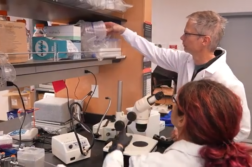ORLANDO, Fla. (Ivanhoe Newswire) — About one in every eight women will have breast cancer at some point in her life. So, how can you lower your risk?
More than 3.1 million women in the U.S. are living with breast cancer right now. But, you don’t have to become one of them.
First, watch your weight. One study found women who gained 21 to 30 pounds after age 18 were 40 percent more likely to develop breast cancer than those who didn’t gain more than five. Another tip, spend less time sitting. In a study, women who sat for six hours a day or longer when not working had a ten percent higher risk of breast cancer compared to those who sat less than three hours.
Next, limit alcohol. Women who have two to three drinks a day have about a 20 percent higher risk of breast cancer compared to those who don’t drink. The American Cancer Society recommends no more than one alcoholic drink a day for women. Lastly, if you do develop breast cancer, early detection is crucial for a good outcome.
Cynthia Litwer, MD, at Cedars-Sinai Imaging says, “The mammogram is basically the gold standard and that’s the one that’s been studied the most and has shown to actually decrease deaths from breast cancer.”
The five year survival rate for breast cancer that’s found early is 99 percent. See your doctor right away if you feel a lump and make sure you have all recommended screening tests.
Some experts also recommend you avoid hormone replacement therapy. This treatment can up your risk of breast cancer. But if you stop taking it, your risk returns to normal within five years.
Contributors to this news report include: Julie Monheim, Producer; Roque Correa, Editor.
Free weekly e-mail on Medical Breakthroughs from Ivanhoe. To sign up: http://www.ivanhoe.com/ftk
5 EASY WAYS TO CUT BREAST CANCER RISK
REPORT #2480
BACKGROUND: There are currently about 3 million women living with breast cancer in the United States. Experts estimate that 252,710 women will be diagnosed just this year. The average survival rate for people with breast cancer is 90% over a 5 year period. If the cancer has spread to the regional lymph nodes, the 5 year survival rate is 85%. And, if the cancer has spread to a distant part of the body, the 5 year survival rate is 26%. New treatments help many people with advanced stage breast cancer maintain a good quality of life. Each person’s risk depends on many factors, including the size of the tumor, the number of lymph nodes that contain cancer and other features of the tumor that affect how quickly it will grow and how well treatment works. Breast cancer is the second most common cause of death from cancer in women in the United States, after lung cancer. However, since 1989, the number of women who have died of breast cancer has steadily decreased thanks to early detection and treatment improvements.
(Source: https://www.cancer.net/cancer-types/breast-cancer/statistics)
EFFECTIVE TREATMENTS: Mammograms are the most effective way to detect breast cancer. They can find lumps up to 2 years before you or a doctor can feel them by hand. The American Cancer Society recommends women have one every year starting at age 45. However, the U.S. Preventive Services Task Force says women should have mammograms every 2 years between the ages of 50 and 74. Imaging tests such as digital mammography, 3-D mammography, and ultrasound can help determine if the lump has the physical features of a tumor. The only way to confirm that it’s cancer is to take some of the cells from the lump and look at them under a microscope through performing a biopsy. The treatment options for breast cancer depend on the size of your tumor and how far it has spread in your body, your age, and how healthy you are. For most, the first step is to remove the tumor with surgery. Your doctor might recommend chemotherapy after surgery to kill any remaining cancer that the operation left behind. This helps reduce the chance that breast cancer will come back. In radiation treatment, high-energy waves destroy the cancer cells. Doctors usually give radiation therapy after a lumpectomy and sometimes after a mastectomy to reduce the risk of cancer coming back in the same breast.
(Source: https://www.webmd.com/breast-cancer/understanding-breast-cancer-treatment#1)
NEW RESEARCH FOR EARLIER DETECTION: A new study suggests that exposure to certain chemicals in the environment, especially early in life, is linked to a higher risk of breast cancer. Depending on where you live and work, you’re likely to be exposed to a number of chemicals every day. It’s important to know that the hazards of chemical exposures depend on a lot of things, including the amount of exposure, the frequency of exposure, the duration of exposure, and your age when exposed. Kathryn Rodgers, a research scientist at the Silent Spring Institute in Massachusetts, a nonprofit organization dedicated to studying links between environmental chemicals and women’s health, says, “During these so-called windows of susceptibility, the body is changing, breast cells are dividing quickly, and the breast tissue becomes vulnerable to damage from chemicals. Unfortunately, it’s hard to measure exposures to multiple chemicals at multiple times in a person’s life.” Most of the data currently collected has come from laboratory animals, not people.
(Source: http://www.breastcancer.org/research-news/chemical-exposure-early-in-life-increases-risk)
ADDITIONAL LINK: http://www.breastcancer.org/research-news/72-new-genetic-mutations-linked-to-bc-found
* For More Information, Contact:
Sandra Tansman
Cedar-Sinai Imaging



